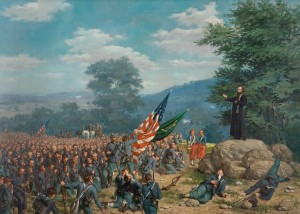Tracing the Irish in the American Civil War
Published in 18th-19th Century Social Perspectives, Featured-Archive-Post, Features, Issue 6 (November/December 2014), Volume 22
Detail from Absolution under fire by Paul Wood—Union soldiers of the Irish Brigade after the Battle of Gettysburg, July 1863. (The Snite Museum of Art)
Earlier this year I wrote about Irish involvement in the First World War and how, although the numbers of Irish involved are still contested, official estimates currently stand at 210,000 mobilised and 49,300 dead. There is another war in which Irish soldiers fought and died in similar numbers but which is forgotten by official Ireland: the American Civil War of 1861–5—all the more surprising considering how we have courted the American connexion.
Irish involvement on both sides of the American Civil War was one of the defining moments in the creation of Irish-American identity. The Irish experience of that war shaped the political consciousness of these men, in particular through various Fenian/IRB organisations like Clan na Gael. Between 1861 and 1865 c. 200,000 Irishmen fought in the American Civil War: 180,000 in the Union army and 20,000 in the Confederate army. An estimated 20% or 23,600 of the Union navy were Irish-born. We don’t yet have comparable figures for the smaller Confederate navy. The total number of the Irishmen who died in this conflict has been estimated at 30,000. All these figures are likely to be revised significantly upwards, as digitisation of the records facilitates data-mining. There are very few short cuts in research, but the digital revolution in on-line records has delivered the two main sources to start researching the Irish in the American Civil War.
Compiled Military Service Records (CMSR)
The CMSR are soldiers’ service records, collated after 1886 from contemporary documents. These are essentially abstracts of evidence taken from original documents, including enlistment, muster and pay rolls; death notices; hospital and prison registers; and descriptive accounts/ service narratives. These records survive for soldiers of the Union and the Confederacy, for each regiment in which they served. There are more than double the number of records than there were soldiers, so scrutinise all matching records for duplicates. An index to the CMSR is available free on-line. It provides a basic index—name, rank, unit and state—by which you may identify individual service records on microfilm (https://familysearch.org/search/collection/1910717).
The [Civil War] Soldiers and Sailors (CWSS) database is currently under construction. On completion this will be a Civil War portal-site and will include records of battles and military units, burial records in the national cemeteries, prisoners and medals of honour (http://www.nps.gov/civilwar/soldiers-and-sailors-database.htm).
Pension records
Civil War pension records for Union soldiers are also available on the subscription site Ancestry.com (http://search.ancestry.com/search/db.aspx?dbid=4654). As a rule of thumb, pension records contain the most genealogical evidence. These can include personal letters written or received by soldiers on active service, narratives of events in service, and documents of births, marriages and deaths submitted as evidence to support a pension application by a dependant (parents, widows or dependent children). Pension files for Confederate soldiers are held in the state archives (Alabama, Arkansas, Florida, Georgia, Kentucky, Louisiana, Mississippi, Missouri, North and South Carolina, Oklahoma, Tennessee, Texas and Virginia).
Fiona Fitzsimons is a director of Eneclann, a Trinity College campus company, and of findmypast Ireland.
Further reading
D. Shiels, The Irish in the American Civil War (Stroud, 2013).
















